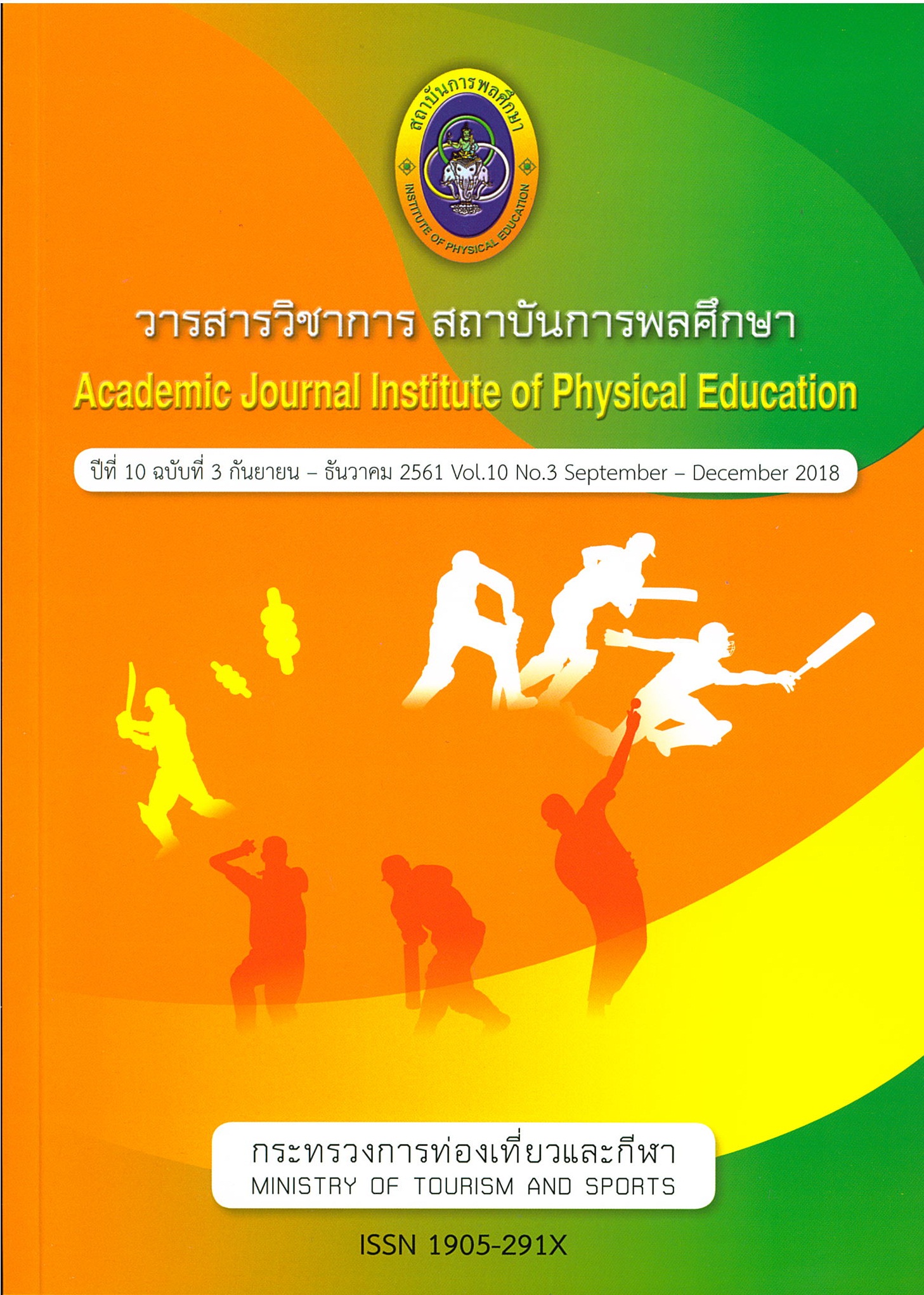Acute Effects of Antagonistic Muscles Exercise With Different Resistance on Performance of Agonistic Muscles
Main Article Content
Abstract
The purpose of this study was to examine the effects of different intensities of antagonist exercise on performance of agonist muscles. Subjects were 11 healthy males (18-22 years, 70.50 ± 3.7 kg., 176.33 ± 3.03 cm., BMI were 22.68 ± 1.20 kg./m., and relative strength were 1.01 ± 0.04.) Subjects were selected by random sampling. Subjects came to the laboratory on 5 different occasions, with a minimum rest interval of 5 days. On the first visit, Subjects were familiarized with 1 RM. Testing of bench press and bench pull. On the second, third, fourth and fifth visits, subjects performed pre-test by bench press throw 30% 1RM. of bench press 5 times and then subjects performed bench pull exercise with random counter balancing in 4 intensities such as 20% 1 RM., 40% 1 RM., 60% 1 RM. and 80% 1 RM. of bench pull 8 times and followed immediately post-test by 5 times of bench press throw. Data analysis was performed by using One-way Analysis of Variance with Repeated Measures with multiple comparisons by Bonferroni method. The results of this study indicated that once subjects had carried out bench pull exercises with 80% 1 RM, their levels of force and power were noticeably high immediately post bench press throw test. Velocity of immediately bench press throw test after bench pull exercise at 80% 1 RM. was greater than at 20% 1RM.
Article Details
The published article is a copyright of the Academic Journal of Thailand National Sports University. The passage appeared in each article in this academic journal is a perspective of each author which is not related to the journal. Each author is required to be responsible for all components of his/her own article. If there are any mistakes, each author must be responsible for those mistakes on his/her own.
References
Baker, D., and Newton, R. U. (2005). Acute effect on power output of alternating an agonist and antagonist muscle exercise during complex training. The Journal of Strength & Conditioning Research, 19(1), 202-205.
Barnett, C., Kippers,V. and Turner,P. (1995) Effects of variations of the bench press exercise on the EMG activity of five shoulder muscles. The Journal of Strength & Conditioning Research, 9(4), (pp.222-227).
Burke, D. G., Pelham, T. W., and Holt, L. E. (1999). The influence of varied resistance and peed of concentric antagonistic contractions on subsequent concentric agonistic efforts. The Journal of Strength & Conditioning Research, 13(3), 193-197.
Carregaro, R. L., Gentil, P., Brown, L. E., Pinto, R. S., and Bottaro, M. (2011). Effects of antagonist pre-load on knee extensor isokinetic muscle performance. Journal of sports sciences, 29(3), 271-278.
Carregaro, R., Cunha, R., Oliveira, C. G., Brown, L. E., and Bottaro, M. (2013). Muscle fatigue and metabolic responses following three different antagonist pre-load resistance exercises. Journal of Electromyography and Kinesiology, 23(5), 1090-1096.
De Freitas Maia, M., Paz, G. A., Souza, J., and Miranda, H. (2015). Strength performance parameters when adopting different exercise sequences during agonist–antagonist paired sets. Apunts. Medicina de l’Esport, 50(187), 103-110.
Egger, G. (1989) The Fitness Leader’s Exercise Bible, Roseville, NSW: Kangaroo Press.
Elliott, B. C., Wilson, G. J., and Kerr, G. K. (1989). A biomechanical analysis of the sticking region in the bench press. Medecine Science Sports Exercise, 21(4), 450-462.
Hamilton, N. P. (2011). Kinesiology: Scientific basis of human motion. Boston, MA : WCB/McGraw-Hill. (pp.56,88-89)
Maia, M. F., Willardson, J. M., Paz, G. A., and Miranda, H. (2014). Effects of different rest intervals between antagonist paired sets on repetition performance and muscle activation. The Journal of Strength& Conditioning Research, 28(9), 2529-2535.
McArdle,W. D.,Katch,F. I.,and Katch,V.L. (2010). Exercise physiology: nutrition, energy, and human performance. Philadelphia, PA: Lippincott Williams & Wilkins. (pp.450)
Muscolino, J. E. (2014). Kinesiology: the skeletal system and muscle function. Toroto, ON: Elsevier Health Sciences. (pp.449-460,580)
Robbins, D. W., Young, W. B., Behm, D. G., and Payne, W. R. (2010). The effect of a complex agonist and antagonist resistance training protocol on volume load, power output, electro myographic responses, and efficiency. TheJournal ofStrength & Conditioning Research, 24(7), 1782-1789.
Sale, D., and MacDougall, D. (1981). Specificity in strength training: a review for the coach and athlete. Canadian journal of Applied Sport Sciences, 6(2), 87-92.
Stone, W. J., and Kroll, W. A. (1991). Sports conditioning and weight training: programs For athletic competition. Boston, MA : WCB/McGraw-Hill. (pp.56,88-89)


